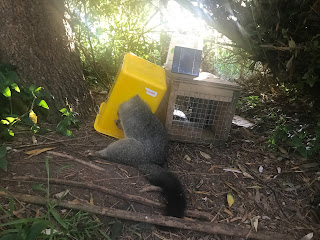For the third consecutive night we have had success at the location where we have been again focussing on the sound lure combined with a Timms trap.Update: Monday 8th November (Day Three). There was a further activation overnight, which was clearly a possum strike on the Timms trap, in this instance the trap was activated, the bucket had moved with the pins pulled up and the bait removed - this has been seen before when a possum activates the trap and then subsequently escapes.
Night Two Summary
In the photo you can see the sound lure immediately behind the Timms trap, were it is linked to trap. Next to the Timms is the stoat box which is still baited with salted rabbit to target stoats.
A smaller female has been caught, interestingly the bait in the Timms trap was not present suggesting that another animal or this animal had removed it, but then continued to interact in the trap resulting in its removal.
Incredibly frustratingly we cannot answer the question with absolute certainty as the event was being monitored by a trail camera that despite prior testing did not operate (record) as had been anticipated. This is our final operational HD Video camera and until we repair our current stock or replace it (which is challenging as we have spent our funding and currently winding the project up). Our project funding closed and we are currently trying to maintain the project on cameras that were initially purchased two years ago.
However if we reflect on our goal from the past two weeks and answering the question of a deterrent we can state the following.
Brush tailed possums were clearly active in the area when the sound lure was operating from inside the DOC 200. There was interest shown in the unit when it operated but the possums did not show signs of stress or a change in behaviour when the unit operated (such as stopping feeding or showing signs of aggression), This behaviour was repeated over several nights, including what appeared to be the same animals return to the site repeatedly. We can surmise the unit did not repel animals during this time. There was limited food placed around the trap to see if the animals would feel safe enough to feed when the unit was operating.
Brush tailed possums were clearly active in the area where the sound lure was operating from inside the rat box. We saw evidence of repeated visits to the site from a range of animals including animals clearly remaining on the site for an extended period of time. There was evidence of some aggressive stance from the male possums who were seen, and some evidence of behaviour leaving the site from a female and a baby. It is possible that this was the arrival of another animal (as the timing on the camera would suggest) or the unit operating. If animals did leave the site they appeared to reappear later in the night, and then spend extended time at the location. We saw evidence of interest shown in the lure and also the general trap area including the possums opening the box the sound lure was hidden in.
Changing the unit set up to switch to a removal phase involved taking the unit and placing the speaker at the rear of a Timms possum trap allowed us to trap a series of possums.
Over two (now three) consecutive nights two possums were caught, a male on Friday night and a female on Saturday. The male showed evidence of being clawed after being caught (which would be by another male as seen before) as fur was present around the trap. The female was caught although the bait was missing from the Timms. The third night saw the trap clearly activated, pulled from the ground and the bait removed, however the animal (which is almost certainly a possum) was able to escape from the trap.
This is showing us that the use of the Timms to increase the sound (as it echoes inside the bucket) making the noise louder is not deterring the animals from the site. This is two consecutive captures a a third nearly clearly occurred over three consecutive nights.
It is very frustrating from our point of view that technical issues with the trail camera has prevented us from recording the interactions on the final phase of the trapping - while we would not have posted the footage here on this public blog for obvious reasons we would have had some more conclusive evidence to ask our short term focus question. This would reinforce what the evidence from the last two years has strongly suggested to us about the viability of the unit and the potential affect that it has had.
I finally feel again compelled to remind everyone that this entire research and operation is being run on a part time basis by (primarily) two people operating in their 'spare' time. This is not being conducted as a full time scientific investigation and I would suggest that these results are open to interpretation.










